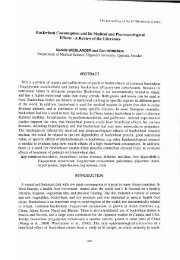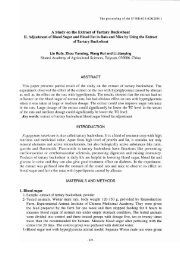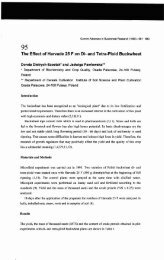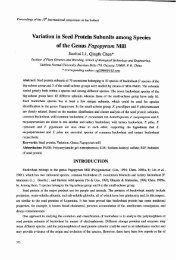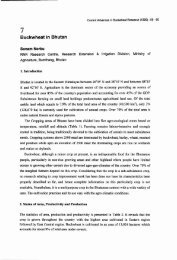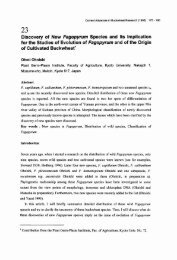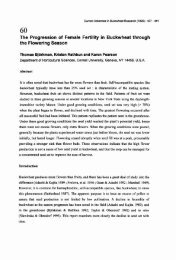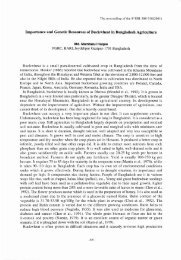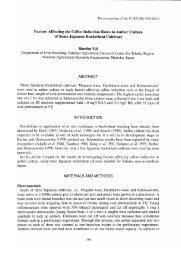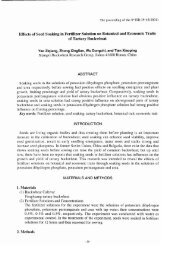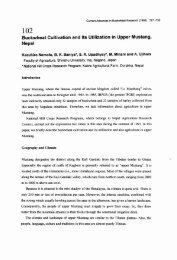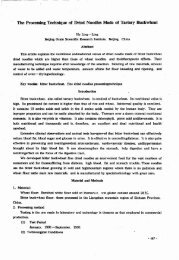Fagopyrum tataricum
Fagopyrum tataricum
Fagopyrum tataricum
Create successful ePaper yourself
Turn your PDF publications into a flip-book with our unique Google optimized e-Paper software.
Proceedings ofthe 9th International Symposium on Buckwheat, Prague 2004<br />
Speciation of<strong>Fagopyrum</strong> <strong>tataricum</strong> Inferred from Molecular Data<br />
Kyoko Yamane, Koji Tsuji, and Ohmi Ohnishi*<br />
Graduate School ofAgriculture, Kyoto University, Nakajoh 1, Mozume-cho, Mukoh 617-0001, Japan<br />
(*corresponding author)<br />
ABSTRACT<br />
A phylogenetic tree, reconstructed from cpDNA sequences, demonstrated that F. tatar~cum (including<br />
both wild and cultivated forms), a close relative of F cymosum, was completely mcluded 1D the<br />
Tibet-Himalayan clade of F. cymosum. This finding strongly indicated that the inbreeding species F.<br />
<strong>tataricum</strong> arose by differentiation from the outcrossing species F. cymosum in the Tibet-Himalayan area.<br />
The matKsequences gave an estimation that these two species diverged approximately 1.9 million years<br />
ago. It was found that natural populations ofF. cymosum maintained a high amount ofgenetic variations<br />
within the species, whereas F. <strong>tataricum</strong> possesses a fairly low level. Since F. cymosum and F <strong>tataricum</strong><br />
are crossable with each other, this suggested that F cymosum may be a good genetic resource for the<br />
improvement of cultivated Tartary buckwheat.<br />
Keywords: <strong>Fagopyrum</strong>, Fagopurum cymosum, <strong>Fagopyrum</strong> <strong>tataricum</strong>, matK, sequence, speciation<br />
INTRODUCTION<br />
Tartary buckwheat is a self-fertilizing diploid (2n=16) species and has both a cultivated, F<br />
<strong>tataricum</strong> ssp. <strong>tataricum</strong> Gaertn. and a wild fonn, F <strong>tataricum</strong> ssp. potanini Batalin. Tartary<br />
buckwheat is mainly cultivated in southern China and in the Himalayan hills. Wild Tartary is<br />
found growing in the Yunnan and Sichuan provinces of China, the Tibetan plateau, and in the<br />
high Himalayan hills of Nepal, India, and Pakistan (OHNISHI, 1994, 1995, 1998a, 2000), F<br />
<strong>tataricum</strong> was always found to be distributed north of the northern most boundaries for the<br />
distribution ofF cymosum (OHNISHI AND YASUI, 1998).<br />
Tartary buckwheat is a nutritionally important food in many areas. It contains a'balanced<br />
amino acid composition and a relatively high content of crude fiber as well as the vitamins B1<br />
and B2. Moreover, Tartary buckwheat seeds contain a larger amount of rutin (>80 folds) than<br />
do common buckwheat seeds (FABJAN ET AL., 2003). Rutin has antioxidative, antihypertensive<br />
and anti-inflammatory activities with buckwheat being the only grain to contain rutin in its<br />
seeds.<br />
<strong>Fagopyrum</strong> cymosum Meisn., commonly known as perennial buckwheat, is a herbaceous,<br />
perennial insect-pollinated heterostylous species. In contrast to the large differences between F.<br />
cymosum and F <strong>tataricum</strong> in their morphological characteristics and breeding habits, KJSHlMA<br />
et al. (1995) first reported that F cymosum was related to F. <strong>tataricum</strong> more closely than to F<br />
esculentum based on a chloroplast DNA restriction site survey. YASUI AND OHNISHI (1998a and<br />
b) confinned this by observing a synapomorphic deletion in the F cymosum-F. <strong>tataricum</strong> clade<br />
of their phylogenetic tree. More recently, YAMANE ET AI. (2003) gained an insight into the<br />
origin ofT <strong>tataricum</strong> as differentiating from F cymosum in the Tibet-Himalayan area based on<br />
the nucleotide sequences from three chloroplast regions.<br />
In the present paper, we attempted to estimate the speciation time ofF <strong>tataricum</strong> from F<br />
cymosum based on matK sequences. Moreover, we show that F cymosum may be a good<br />
genetic resource for the improvement of Tartary buckwheat, by demonstrating that there is a<br />
large amount of genetic variation in F cymosum but a limited amount in F <strong>tataricum</strong>.<br />
MATERIALS AND METHODS<br />
The analysis ofthe trnKlmatK sequences<br />
Data from the matK sequences ofsix, four and one accessions ofdiploid F cymosum, F.<br />
<strong>tataricum</strong>, and F. esculentum (as an outside group), respectively, were obtained from GenBank.;<br />
317
Proceedings ofthe 9th International Symposium on Buckwheat, Prague 2004<br />
the accessions numbers (GenBank number) being C9438 (AB093075), C9435 (AB093072),<br />
C8924 (AB09371), C8926 (AB093074), C8927 (AB093081), YC9806 (AB093082) of F.<br />
cymosum, C9532 (AB093083), C9542 (AB093084) of F. <strong>tataricum</strong> ssp. potanini, CT9835<br />
(AB093085), C9044 (AB093086) ofF. <strong>tataricum</strong> ssp. <strong>tataricum</strong>, and C9106 (AB093087) ofF.<br />
esculentum (YAMANEETAL. 2003). The locations ofthese accessions (village or town, province,<br />
and country) are given in Figure 1. The F. <strong>tataricum</strong> samples were carefully selected from those<br />
used by TSUJI AND OHNISHI (2000, 2001a, b) so that a small number of samples would<br />
encompass the entire variation. The nucleotide sequences were aligned manually using<br />
DNASIS version 3.0 (Hitachi Software Engineering Co. Ltd., Tokyo, Japan), with manual<br />
modifications to minimize the number of gaps. We used DnaSP version 3.5 to estimate the<br />
nucleotide diversity (1£) and the number of net nucleotide substitutions between the two<br />
populations (DA) (NEI, 1987). The phylogenetic relationships were inferred by the<br />
neighbor-joining (NJ) method (SAITOU AND NEI, 1987) which was performed using PAUP<br />
4.0b10 (SWOFFORD, 1999). The number of nucleotide substitutions per site was estimated by<br />
Kimura's (1980) two-parameter method and used to estimate the genetic distance. All<br />
informative substitutions were used in the analyses, and indels were treated as missing data in<br />
both methods. PAUP was also utilized to perform bootstrap analyses (1000 replicates) to<br />
estimate the relative support for the clades (FELSENSTEIN, 1985).<br />
Figure 1.<br />
A NJ tree reconstructed using nucleotide sequences of the trnKl matK region.<br />
Bootstrap values for 1000 replicates are shown above the branch, but values of less than 50%<br />
are not shown.<br />
Genetic variations of diploid R cymosum and R <strong>tataricum</strong><br />
In order to evaluate the possibility ofF cymosum as a genetic resource for F <strong>tataricum</strong>,<br />
we reanalyzed the published data on allozyme variation in F. cymosum and F. <strong>tataricum</strong><br />
(OHNISHI 1998b; YAMANE AND OHNISHI, 2001; Table 1), chloroplast DNA sequences (YAMANE<br />
ET AL., 2003; Table 2), and theAdh sequences (YAMANE, 2003; Table 2), and compared genetic<br />
variations between F <strong>tataricum</strong> and diploid F. cymosum.<br />
, Tab. 1 Levels ofallozyme variation at the species level in F. cymosum and F. <strong>tataricum</strong>.<br />
F cymosum (2X)<br />
F <strong>tataricum</strong><br />
YAMANE AND OHNISHJ (2001)* 1 OHNISHI (1998)* 1<br />
Number ofinvestigated populations 10 148<br />
Number ofinvestigated loci 9 17<br />
Number ofpolymorphic loci 8 4<br />
Percentage (%) ofpolymorphic locus 0.89 0.24<br />
Other plants *2 0.50 (Outcrossing species) 0.42 (Selfinf,! species)<br />
Average number ofallele per loci 3.20 1.40<br />
*\calcu)ated based on the data in these papers.<br />
*2; After HAMRICK AND GODT (1989).<br />
Other plants ~ 1.99 (Outcrossing species) 1.69 (Selfing species)<br />
318
Proceedings ofthe 9th /nlematiQIWI Symposium 01'1 Buckwheat, Prague 2004<br />
Tab. 2 Nucleotide diversities (n) ofthe marK and the Adh sequences in F <strong>tataricum</strong> and diploid<br />
F. cvmosum.<br />
matK<br />
Adh<br />
Species<br />
Yamane et a1. (2003~ Yamane (2003)<br />
Diploid F cymosum (n=6) 0.0036 0.0074<br />
P. <strong>tataricum</strong> (0=4) 0.0003 0.0022<br />
krabidopsis thaiiana (selfmg species)'j - 0.0080<br />
IArabis zemmidera (outcrossinll soecies) OJ<br />
~<br />
0.0053<br />
*1; MIYASHITA ET AL. 1996 and 2001. n' number ofaccessions analyzed.<br />
RESULTS<br />
Phylogenetic position of R <strong>tataricum</strong><br />
A total of 2413 characters were analyzed for the trnK/matK sequences. As shown in<br />
Figure 1, F. cymosum consisted of two major clades. The reconstructed tree showed that the<br />
phylogenetic relationships within F. cymosum coincided with the geographic locations of the<br />
accessions; one consisting of the accessions from Tibet, which includes the accessions of F<br />
<strong>tataricum</strong> (Tibet-Himalayan clade), and the other consisting ofthe F. cymosum accessions from<br />
the Yunnan and Sichuan provinces of China.<br />
Fig. I A NJ tree reconstructed using nucleotide sequences ofthe trnKJ rnatK region. Bootstrap<br />
values for 1000 replicates are shown above the branch, but values of less than 50% are<br />
not shown.<br />
61<br />
C8liQ.4~ 'Y'unr.-n, QIN)<br />
C882ll~YIn8l. Chn.)<br />
CtIiXf~Ouilhou. Ctln.><br />
_O.lXn~<br />
C8e5~n. V\l"""",an)<br />
1...-__ aM38~ SIchuan, CIWIal<br />
tBricum<br />
T1<br />
I J<br />
about 1.92 milion ears<br />
YaJeOe ('Tong!reI,,...Qlln.)<br />
Polymorphisms in F. cymosum and F. <strong>tataricum</strong><br />
Table 1 shows the comparison for allozyme variability's between the two species.<br />
Although the kind and number of enzymes analyzed were not the same in the two studies, the<br />
level of allozyme variation was obviously different between the two species; i. e., natural<br />
populations of F cymosum maintained a greater amount of allozyme variations within the<br />
species, wherea
Proceedings ofthe 9th International Symposium on Buckwheat, Prague 2004<br />
self-fertilizing plant species (HAMRICK AND GODT, 1989). Likewise, Table 2 shows that the<br />
level of chloroplast and nuclear nucleotide variation was higher in F. cymosum than in F.<br />
<strong>tataricum</strong>.<br />
DISCUSSION<br />
Speciation ofE <strong>tataricum</strong> from R cymosum<br />
All the accessions ofF <strong>tataricum</strong> were included in one clade of the phylogenetic tree,<br />
and the phylogenetically closest accession to F. <strong>tataricum</strong> was found to be diploid F cymosum<br />
from Tongmai in Tibet (YAMANE ET AL., 2003; Figure 1). We therefore concluded that F.<br />
<strong>tataricum</strong> speciated from F cymosum in the Tibet-Himalayan region. Interspecific hybrids<br />
between F. cymosum and F <strong>tataricum</strong> are extremely difficult to obtain by conventional<br />
breeding methods; i. e. the reproductive isolation between these two species is strict (WOO ET<br />
AL, 1999). The breakdown ofthe self-incompatibility system in F. <strong>tataricum</strong> might have led to<br />
rapid reproductive isolation of F <strong>tataricum</strong> from its progenitor. In traditional theories of<br />
speciation, reproductive isolation may originate from an incidental by-product ofadaptation to<br />
distinct environments (DOBZHANSKY, 1951).<br />
We estimated the approximate time of divergence between F <strong>tataricum</strong> and the<br />
accession of F cymosum from Tongmai to be approximately 1.9 MYA by utilizing the same<br />
method as YAMANE ET AL. (2003). Interestingly, the speciation time of F. <strong>tataricum</strong>, 1.9 MY;<br />
corresponds approximately to the end of the Pliocene era and the beginning of Quaternary<br />
(Pleistocene) (YAMANE ETAL., 2003). During this period, the global climate around Tibet turned<br />
cold and dry, according to pollen data and the age of Mt. Everest and other localities (ZHOU,<br />
1985). F <strong>tataricum</strong> has always been found to be distributed north of the northern most<br />
boundaries for the distribution ofF cymosum (OHNISHI AND YASUl, 1998). It therefore appears<br />
that F <strong>tataricum</strong> has adapted to cooler environments. This may have played an important role in<br />
the speciation ofF <strong>tataricum</strong> from F. cymosum.<br />
Evaluation ofR cymosum as genetic resources<br />
The present data indicated that F. cymosum contains a large amount of intraspecific<br />
genetic variation. It also suggested that populations from different habitats evolved<br />
independently and may possess newly arisen genotypes as a result of adaptation to differing<br />
local environmental conditions. In contrast, F. <strong>tataricum</strong> demonstrated low intraspecific genetic<br />
diversity in allozyme variations (Table 1), cpDNA variations and in the nucleotide sequence of<br />
the Adh gene (Table 2). These findings lead to the assertion that F cymosum may be utilized as<br />
an important genetic resource or gene reservoir which could be utilized in the improvement of<br />
cultivated Tartary buckwheat. When F. cymosum was used as the male parent, hybrids between<br />
F. cymosum and F <strong>tataricum</strong> can be successfully developed into mature plants through embryo<br />
rescue methods (WOOETAL., 1999). Therefore, introgression ofuseful genes from F. cymosum<br />
into cultivated Tartary buckwheat may help solve important agricultural problems such as water<br />
stress injury, disease resistance, and increased yield in the future. In addition, a diploid<br />
population ofF cymosum from the Tibet-Himalayan area was recently discovered (TSUJI ETAL.,<br />
1999). Ithas unique achene morphology and it was revealed that this population had genetically<br />
diverged from the other diploid populations of F cymosum. Therefore, conservation and<br />
utilization of these types ofF cymosum may be necessary at the population level.<br />
REFERENCES<br />
DOBZHANSKI, T. (1951): Genetics and the origin of species. New York: Columbia University Press.<br />
ed. 3.<br />
FABJAN N., 1. RODE, 1. J. KosIR, Z. WANG, Z. ZHANG, AND IVAN KREFT (2003): Tartary buckwheat<br />
(<strong>Fagopyrum</strong> tataricurn Gaertn.) as a source ofdietary rutin and quercitrin. J. Agric. Food Chern.<br />
51, 6452-6455<br />
320
Proceedings afthe 9th International Symposium on Buckwheat, Prague 2004<br />
FELSENSTEIN, J. (1985): Confidence limits on phylogenies: an approach using the bootstrap. Evolution<br />
39: 783-791.<br />
HAMRICK lL. AND GoDT J. W. (1989): Allozyme diversity in plant species. In: BROWN AH.D., CLEGG<br />
M.T., KAHLER AL. AND WEIR B.S. (Eds.), Plant Population Genetics, Breeding, and Genetic<br />
Resources, pp. 43-63. Sinauer, Sunderland, MA.<br />
KlMuRA, M. (1980): A simple method for estimating evolutionary rates of base substitutions through<br />
comparative studies ofnucleotide sequences. Journal ofMolecular Evolution 16: 111-120.<br />
KISHIMA, Y., K OGURA, K MIZUKAMI, T. MIKAMl, AND T. ADACHI (1995): Chloroplast DNA analysis<br />
in buckwheat species: phylogenetic relationships, origin of reproductive systems and extended<br />
inverted repeats. Plant Science 108: 173-179.<br />
MlYASIflTA, T. N. (2001): DNA variation in the 5' upstream region of the Adh locus of the wild plant<br />
Arabidopsis thaliana and Arabis gemmifera. Molecular Biology and Evolution 18: 164-171.<br />
MIYASHITA, T. N., H. INNAN, AND R. TERAUCHI (1996): Intra- and Interspecific variation ofthe Alcohol<br />
dehydrogenase locus region in wild plants Arabis gemmifera and Arabidopsis thaliana.<br />
Molecular Biology and Evolution 13: 433-436.<br />
NEI, M. (1987): Molecular Evolutionary Genetics. Columbia University Press, New York, New York,<br />
USA<br />
OHNISHI, O. (1994): Buckwheat in Karakoram and the Hindkush. <strong>Fagopyrum</strong> 14: 17-25.<br />
OHNISHI, O. (1995): Discovery ofnew <strong>Fagopyrum</strong> species and its implication for the study ofevolution<br />
of <strong>Fagopyrum</strong> and the origin of cultivated buckwheat. In Proceedings of the 6 th International<br />
Symposium ofBuckwheat at Ina, 175-190.<br />
OHNISHI, O. (1998a): Search for the wild ancestor of buckwheat. 1. Description of new <strong>Fagopyrum</strong><br />
(Polygonaceae) species and their distribution in China and Himalayan hills. <strong>Fagopyrum</strong> 15:<br />
18-28.<br />
OHNISHI, O. (1998b): Search for the wild ancestor of buckwheat III. The wild ancestor of cultivated<br />
common buckwheat, and ofTartary buckwheat. Economic Botany 52: 123-133.<br />
OHNISHI, O. AND Y. YASUI. (1998): Search for wild buckwheat species in high mountainous regions of<br />
Yunnan and Sichuan. <strong>Fagopyrum</strong> 15: 8-17.<br />
SAITOU, N., AND M. NET. (1987): The neighbor-joining method: A new method for reconstructing<br />
phylogenetic trees. Molecular Biology andEvolution 4: 405-425.<br />
SWOFFORD, D. L. (1999): PAUP*: Phylogenetic analysis using parsimony (*and Other Methods).<br />
Version 4.0b4a. Sinauer Associates, Sunderland, MA<br />
Tsun K AND OHNISHI O. (1998): Phylogenetic relationships among cultivated landraces and natural<br />
populations of Tatary buckwheat (<strong>Fagopyrum</strong> <strong>tataricum</strong>) revealed by RAPD analyses. Proc. 7t'1J<br />
IntI. Sym. Buckwheat, part VI: 41-49.<br />
Tsun K, YASUI Y. AND OHNISHI 0. (1999): Search for <strong>Fagopyrum</strong> species in eastern Tibet.<br />
<strong>Fagopyrum</strong> 16: 1-6.<br />
Tsun, K., AND O. OHNIsm. (2000): Origin of cultivated Tartary buckwheat (<strong>Fagopyrum</strong> <strong>tataricum</strong><br />
Gaertn.) revealed by RAPD analysis. Genetic Resources and Crop Evolution 47: 431-438.<br />
TSUJI, K., AND O. OHNISm (2001 a): Phylogenetic position ofeast Tibetan natural populations in Tartary<br />
buckwheat (<strong>Fagopyrum</strong> <strong>tataricum</strong> Gaertn.) revealed by RAPD analyses. Genetic Resources and<br />
Crop Evolution 48: 63-67.<br />
TSUJI, K, AND 0, OHNISHI (2001b): Phylogenetic relationships among wild and cultivated Tartary<br />
buckwheat (<strong>Fagopyrum</strong> <strong>tataricum</strong> Gaertn.) populations revealed by AFLP analyses. Genes and<br />
Genetic Systems 76: 47-52.<br />
YAMANE K. (2003): Evolutionary processes pfpolyploidization and genetic differentiation in Perennial<br />
buckwheat (<strong>Fagopyrum</strong> cymosum Meisn.) revealed by molecular markers. (Dr. thesis).<br />
YAMANE, K, AND O. OHNISHI (2001): Phylogenetic relationships among natural populations of<br />
Perennial buckwheat, <strong>Fagopyrum</strong> cymosum Meisn. revealed by allozyme variations. Genetic<br />
Resources and Crop Evolution 48: 69-77.<br />
YAMANE K, Y. YASUI, AND O. OHNISHI (2003): Intraspecific cpDNA variations ofdiploid and tetraploid<br />
perennial buckwheat, <strong>Fagopyrum</strong> cymosum (Polygonaceae). American Journal of Botany 90:<br />
339-346.<br />
321
Proceedings ofthe 9th International Symposium on Buckwheat, Prague 2004<br />
YASUI, Y, AND O. OHNISm (1998a): Interspecific relationships in <strong>Fagopyrum</strong> (Polygonaceae) revealed<br />
by the nucleotide sequences ofthe rbcL and aceD genes and their intergenetic region. American<br />
Journal ofBotany 85: 1134-1142.<br />
YASUI, Y, AND O. OHNISm (1998b): Phylogenetic relationships among <strong>Fagopyrum</strong> species revealed by<br />
nucleotide sequences of the ITS region of the nuclear rRNA gene. Genes and Genetic Systems<br />
73: 201-210,<br />
Woo, S, H., Y. 1. WANG, AND C. G CAMPBELL (1999): Interspecific hybrids with <strong>Fagopyrum</strong> cymosum<br />
in the genus <strong>Fagopyrum</strong>. <strong>Fagopyrum</strong> 16:13-18.<br />
ZHOU, T-R. (1985): Changes ofnatural zones in China since the beginning ofcenozoic era. pp. 176-184.<br />
In: Liu, T. [Ed.] Quaternary Geology and Environment ofChina, China Ocean Press, Beijing.<br />
322




